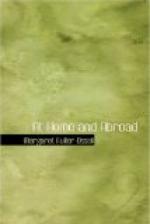The few stories Mrs. Jameson wrote out, though to these also a sentimental air has been given, offend much less in that way than is common in this book. What would we not give for a completely faithful version of some among them! Yet, with all these drawbacks, we cannot doubt from internal evidence that they truly ascribe to the Indian a delicacy of sentiment and of fancy that justifies Cooper in such inventions as his Uncas. It is a white man’s view of a savage hero, who would be far finer in his natural proportions; still, through a masquerade figure, it implies the truth.
Irving’s books I also read, some for the first, some for the second time, with increased interest, now that I was to meet such people as he received his materials from. Though the books are pleasing from, their grace and luminous arrangement, yet, with the exception of the Tour to the Prairies, they have a stereotype, second-hand air. They lack the breath, the glow, the charming minute traits of living presence. His scenery is only fit to be glanced at from, dioramic distance; his Indians are academic figures only. He would have made the best of pictures, if he could have used his own eyes for studies and sketches; as it is, his success is wonderful, but inadequate.
McKenney’s Tour to the Lakes is the dullest of books, yet faithful and quiet, and gives some facts not to be met with everywhere.
I also read a collection of Indian anecdotes and speeches, the worst compiled and arranged book possible, yet not without clews of some value. All these books I read in anticipation of a canoe-voyage on Lake Superior as far as the Pictured Rocks, and, though I was afterwards compelled to give up this project, they aided me in judging of what I subsequently saw and heard of the Indians.
In Chicago I first saw the beautiful prairie-flowers. They were in their glory the first ten days we were there,—
“The golden and the flame-like flowers.”
The flame-like flower I was taught afterwards, by an Indian girl, to call “Wickapee”; and she told me, too, that its splendors had a useful side, for it was used by the Indians as a remedy for an illness to which they were subject.
Beside these brilliant flowers, which gemmed and gilt the grass in a sunny afternoon’s drive near the blue lake, between the low oak-wood and the narrow beach, stimulated, whether sensuously by the optic nerve, unused to so much gold and crimson with such tender green, or symbolically through some meaning dimly seen in the flowers, I enjoyed a sort of fairy-land exultation never felt before, and the first drive amid the flowers gave me anticipation of the beauty of the prairies.
At first, the prairie seemed to speak of the very desolation of dulness. After sweeping over the vast monotony of the lakes to come to this monotony of land, with all around a limitless horizon,—to walk, and walk, and run, but never climb, oh! it was too dreary for any but a Hollander to bear. How the eye greeted the approach of a sail, or the smoke of a steamboat; it seemed that anything so animated must come from a better land, where mountains gave religion to the scene.




